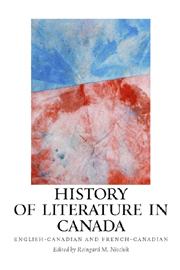Book contents
- Frontmatter
- Contents
- Acknowledgments
- Introduction: Writing a History of Literature in Canada
- I Beginnings
- II The Literature of New France, 1604–1760
- III The Literature of British Canada, 1763–1867
- IV From the Dominion to the Territorial Completion of the Nation, 1867–1918
- V The Modern Period, 1918–1967
- VI Literature from 1967 to the Present
- 21 Sociopolitical and Cultural Developments from 1967 to the Present
- 22 English-Canadian Literary Theory and Literary Criticism
- 23 The English-Canadian Novel from Modernism to Postmodernism
- 24 The English-Canadian Short Story since 1967: Between (Post)Modernism and (Neo)Realism
- 25 English-Canadian Poetry from 1967 to the Present
- 26 Contemporary English-Canadian Drama and Theater
- 27 Canons of Diversity in Contemporary English-Canadian Literature
- 28 Literature of the First Nations, Inuit, and Métis
- 29 The Quebec Novel
- 30 The French-Canadian Short Prose Narrative
- 31 French-Canadian Poetry from 1967 to the Present
- 32 Orality and the French-Canadian Chanson
- 33 Drama and Theater from the Révolution tranquille to the Present
- 34 Transculturalism and écritures migrantes
- 35 The Institutionalization of Literature in Quebec
- Further Reading
- Notes on the Contributors
- Index
32 - Orality and the French-Canadian Chanson
from VI - Literature from 1967 to the Present
Published online by Cambridge University Press: 12 September 2012
- Frontmatter
- Contents
- Acknowledgments
- Introduction: Writing a History of Literature in Canada
- I Beginnings
- II The Literature of New France, 1604–1760
- III The Literature of British Canada, 1763–1867
- IV From the Dominion to the Territorial Completion of the Nation, 1867–1918
- V The Modern Period, 1918–1967
- VI Literature from 1967 to the Present
- 21 Sociopolitical and Cultural Developments from 1967 to the Present
- 22 English-Canadian Literary Theory and Literary Criticism
- 23 The English-Canadian Novel from Modernism to Postmodernism
- 24 The English-Canadian Short Story since 1967: Between (Post)Modernism and (Neo)Realism
- 25 English-Canadian Poetry from 1967 to the Present
- 26 Contemporary English-Canadian Drama and Theater
- 27 Canons of Diversity in Contemporary English-Canadian Literature
- 28 Literature of the First Nations, Inuit, and Métis
- 29 The Quebec Novel
- 30 The French-Canadian Short Prose Narrative
- 31 French-Canadian Poetry from 1967 to the Present
- 32 Orality and the French-Canadian Chanson
- 33 Drama and Theater from the Révolution tranquille to the Present
- 34 Transculturalism and écritures migrantes
- 35 The Institutionalization of Literature in Quebec
- Further Reading
- Notes on the Contributors
- Index
Summary
“La pensée se fait dans la bouche” (Tristan Tzara)
ORALITÉS-POLYPHONIX 16, a festival and symposium that took place in Quebec in June 1991, explored fundamental aspects of orality, its forms and functions as well as its specific Québécois character. Orality can operate both in a printed text and in the act of performing, whose most popular manifestation — next to theater and dance — is the chanson. One of the many facets of orality is the euphonic experiment with linguistic material, which has already been touched upon in connection with surrealist and postsurrealist sound effects and language practices (see ch. 17, Mathis-Moser), and which is especially prominent in the works of, for instance, Claude Gauvreau (1925–1971), the poet, composer, and performer Raoul Duguay (1939–), the “automatists,” and the representatives of Counter Culture. In many cases this particular form of orality was combined with visual experiments that further hybridized genre borders. Thus Duguay created “visible” rhythms in his texts, rhythms that are visually perceivable through their affinity with the score of a composition; and the almost cosmic vision of his “stéréo-poèmeaudio-visuel” (Bayard) mixes calligraphy and “lettrism” with effects of sonority and multimedia experiments.
While such games may appear elitist, the chanson has been extremely popular with a wider audience. As a genuinely Quebec genre that does not exist in the rest of Canada in comparable abundance and variety, it deserves particular attention. It is difficult, however, to clearly distinguish the chanson from the monologue québécois, another genre typical of Quebec.
- Type
- Chapter
- Information
- History of Literature in CanadaEnglish-Canadian and French-Canadian, pp. 470 - 477Publisher: Boydell & BrewerPrint publication year: 2008



